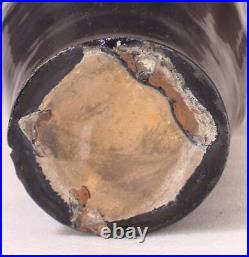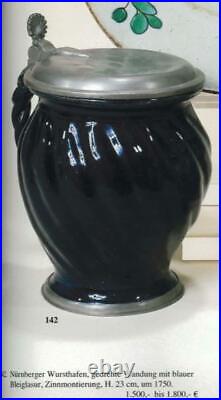





Antique Early German Faience Stein/Wursthafen/Sausage Jar Nuremberg c. Description: Presented is a rare example of early German pottery. This high-fired earthenware dark blue jar was made in Nuremberg. Every German town and every region that was known to make pottery had its own unique technologies and trade secrets. That’s why we can determine where a particular piece was made based on the appearance, style and the type of the pottery. This one was a quite common pottery type in the mid-1700s – it is called “Nurnberg Wursthafen” or Nuremberg sausage jar. It was made in different sizes and usually a household had several of them for each sausage type. They were made by the same factories that manufactured faience beer steins and they employ the same technology – high fired earthenware with lead-based glaze, and usually with the beer stein type lid and the foot ring. The one with the lid is estimated at 1500 – 1800 EUR. This one doesn’t have the lid (not all of them did) and I priced it way lower. However, this is still the same “Nurnberg Wusrthafen” – an interesting and historically significant ceramics artifact. And of the largest size. The jar is large and impressive – it stands 8″ tall and 8″ wide to the handle, with approx. A very similar, almost identical jar only lidded I show in my pictures. The jar is in a good condition, the appearance is excellent. There are some manufacturing issues and impurities – some minor chipping on the bottom rim that is actually glazed over – it was a manufacturing issue – the jar was made by hand after all – but no structural damage whatsoever, no cracks or hairlines, no post-production chips. This condition is usually called “mint” – exactly as it came from the factory. It is very impressive and elegant and a true historical piece that carries almost 300 years of both culture and technology. I guarantee the authenticity. Get images that make Supersized seem small. Track Page Views With. Auctiva’s FREE Counter.
